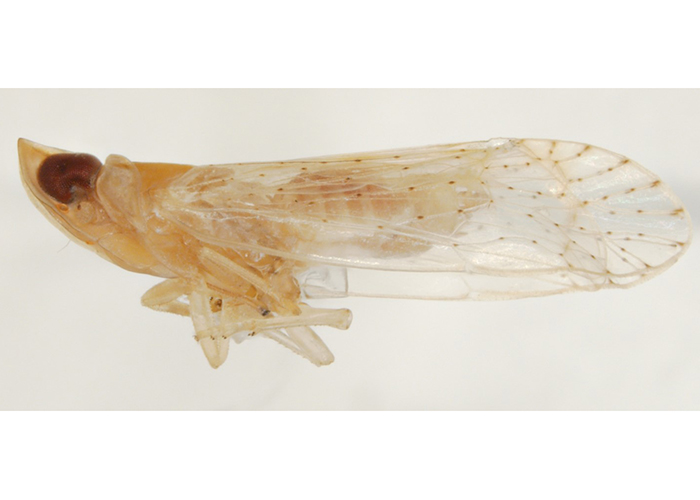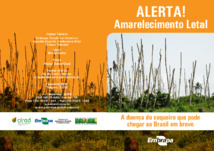Planthopper capable of transmitting serious coconut palm disease discovered in Sergipe
Planthopper capable of transmitting serious coconut palm disease discovered in Sergipe
Photo: Adenir Teodoro

International team identified the new species to potentially threaten coconut groves
Researchers discovered in the Brazilian state of Sergipe a new species of planthopper that can host the agent of coconut Lethal Yellowing (LY or LYD), a serious disease that can reach Brazil and that has already been on the plant health warning list since 2013.
Baptized Oecleus sergipensis (alluding to the name of the state where it was discovered), it is the first planthopper of the Oecleus Stål genus recorded in the Brazilian territory.
Its discovery is the result of an international research effort to identify potential LY vectors in coconut producing regions. The studies involve Embrapa, universities and research institutions in Brazil and abroad, like the French Agricultural Research Centre for International Development (Cirad); and the Yucatan Center of Scientific Research (CICY), in Mexico.
The scholars responsible for the discovery are Flaviana Gonçalves da Silva, holder of a PhD scholarship from the Coordination for the Improvement of Higher Education Personnel (Capes); and Eliana Maria dos Passos,holder of a postdoctoral scholarship from the National Council of Scientific and Technological Development (CNPq) and advised by the researcher Leandro Diniz, from Embrapa Coastal Tablelands. Another member of the group is the researcher Michel Dollet, from Cirad, who has worked in cooperation in Brazil since 2014.
These and other research findings are the results of the project "Improving scientific knowledge on coconut lethal yellowing and other palm diseases”, led by Embrapa, and of the international scientific cooperation network maintained by the Agricultural Research Innovation Marketplace, which gathers researchers from Embrapa and from other institutions.
The specimens were collected between 2015 and 2016 in the coconut gene banks that Embrapa keeps in the town of Neópolis, by the lower São Francisco river in Sergipe, and in Itaporanga d’Ajuda, at the South coast of the state, on top of Augusto Franco park, located next to the Embrapa center in Sergipe's capital city.
In Brazil, the molecular identification of the new species was performed through genetic characterization. The confirmation of the morphologic identification of the new species was made by the researcher from the University of Delaware (Udel) Entomology Department Charles Bartlett, , who is considered the biggest specialist in the Oecleus Stål in the world.
The American scientist has co-authored, jointly with the two scholarship holders, the Embrapa researcher and the French scientist, the paper published in the international magazine Zootaxa - a journal that specializes in the identification of animal species - in which the new planthopper is described.
Researchers from Cirad, France, and from Embrapa explain the coconut Lethal Yellowing Disease (LYD)
Potential LYD vector
So far, the only scientifically confirmed lethal yellowing transmitting agent is the planthopper species Haplaxius crudus.
In the expeditions to collect planthoppers made between 2015 and 2016 by the researchers in Sergipe, Bahia and Alagoas, thousands of individuals were captured, but none of the Haplaxius genus. Specimens of this genus, however, were found in higher numbers (approximately 97%) during a two-week visit to the producing areas of Pará, in 2016.
"At the time, we notified the state's phythosanitary authorities, as well as the Ministry of Agriculture (Mapa). That comprised the first official record of the presence of the known LYD vector in Brazil", reports the researcher Marcelo Fernandes, temporary head of Embrapa Coastal Tablelands and member of the network's project.
A fact that has drawn the scientists' attention is the presence of the LYD in coconut palm plantations in countries of Africa, despite there being no record of planthoppers of the Haplaxius or Oecleus Stål genera in the continent. This increases the suspicion of that other genera and species have potential to transmit the disease.
In Oecleus Stål's case, transmissibility tests in controlled environments, with CICY's support in Mexico, where the disease already occurs, will confirm or disprove such planthoppers' role as vectors.
The researchers had verified that the planthopper discovered in Sergipe has dietary habits that are similar to the known vector's, which sucks the plant's elaborated sap, where, if it is infected, one finds phytoplasma (parasitic bacteria without cell walls).
Surveys and studies conducted in Mexico by the CICY researcher Carlos Oropeza have already indicated the presence of phytoplasma in the digestive systems of the Oecleus Stål planthoppers captured in coconut palm plantations in that country.
The discoveries made by the research network further raise concerns and levels of alert for the arrival of the disease in Brazil, where coconut and other palm groves have economic and landscaping importance.
The diseaseCoconut lethal yellowing is a disease caused by a microorganism of the phytoplasma type that spreads through insects vectors, which feeds from the palm leaves and phloem (elaborated sap), taking the causing agent from one plant to another. Such illness has reached the coconut and other palm groves of Africa, the Atlantic Coast, some islands in North and Central America, and is already found in Mexico and Honduras. When LYD strikes in an area, the landscape changes within months. The coconut groves affected, at the final stage of the disease, have their stipes (name given to coconut palm trunks) left without leaves, recalling poles, and the image contrasts with the tropical beach postcards. Millions of dead palms in the CaribbeanThe disease was responsible for the death of more than seven million palm trees in Jamaica in 1980. Similar epidemics also occurred in Cuba, Haiti, Dominican Republic, Bahamas and Florida. In 1997, the disease reached Cozumel and Cancun, in Mexico, and moved on through the Yucatan Peninsula to Honduras. In last the 30 years, about 50% of the coconut groves of Florida and 80% of the ones in Jamaica died as a consequence of Lethal Yellowing. The infectadas plants die within three to six months after the appearance of the first symptoms. There are no efficient treatments for the disease control. According to Michel Dollet, it is impossible to predict through where or when the disease will reach Brazil. "Lethal yellowing can arrive via Central America, the Caribbean or directly from Florida (USA) or Mozambique, in Africa. Many foci result from imports without control that introduce the disease and its insect vector", he explains. |
Alert system
One of the project initiatives led by Embrapa was editing an alert bulletin about the disease, which had massive distribution among farmers, agricultural defense agents, and technical assistants in producing regions. The publication has been available online since 2015.
Agricultural defense agents in producing states where there the disease can potentially appear (i.e. Sergipe, Roraima and Pará) were trained by the researchers to recognize the symptoms and to adequately collect plant parts to be examined in laboratory.
Another project action was to promote the preparation of three laboratories in the country to receive the samples and to conduct the plant pathology tests for the safe and accurate identification of the phytoplasma that causes LYD.
In 2018 the project started to set up sentinel plantations in areas with potential for disease in Brazil. Such parcels will be continuously monitored for fast detection in case the disease appears.
The symptoms appear in a sequence, starting by the sudden fall of all the plant fruits, both big and small; after that, one can observe the yellowing of the oldest leaves, which are in the lowest portion of the plant; then comes the darkening, brown spots and necrosis of the flowers; the next stage is the progression of the leaf yellowing from the bottom to the top - after yellowing, the leaf becomes brown and falls; in the final stage there is rotteining and plant death, leaving the stem without leaves.
Resistance
In the scope of the Marketplace, and with the aim to identify potential tolerance and resistance among green dwarf coconut palm varieties (used to produce coconut water), Embrapa sent Brazil green dwarf (BGD)-type of materials from the gene bank in Sergipe to be planted in open fields in Mexico, with CICY's support.
In November 2018, the researchers Elio Guzzo and Elias Ribeiro, from Embrapa Coastal Tablelands, visited cultivated areas in the North American country to observe the behavior of BGD coconut in light of the disease.
They observed that in places where LYD occurs and had already striken several coconut palms, the Brazilian variety did not present symptoms. This fact is a promising indication that the variety, which is widely cultivated in Brazil, has great potential for tolerance and resistance to phytoplasma.
Translation: Mariana Medeiros Saulo Coelho (MTb 1065/SE)
Embrapa Coastal Tablelands
Press inquiries
tabuleiros-costeiros.imprensa@embrapa.br
Phone number: +55 79 4009-1381
Further information on the topic
Citizen Attention Service (SAC)
www.embrapa.br/contact-us/sac/


